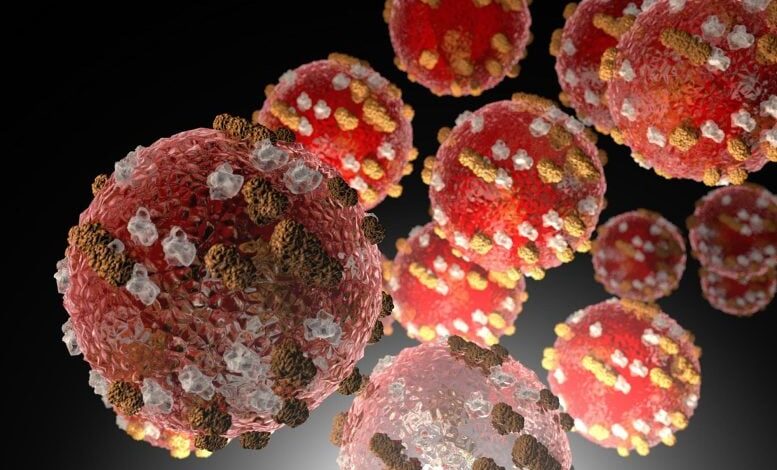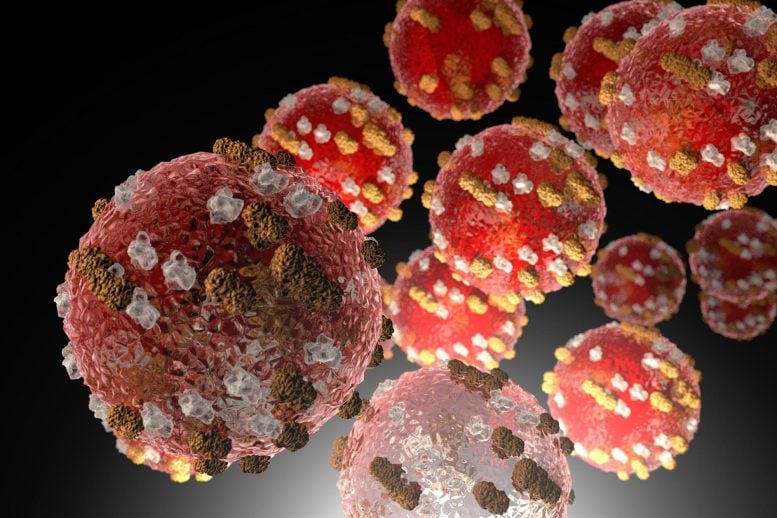Fusion Protein Breakthrough Paves Way for Novel Measles Vaccine


A new study highlights an innovative approach to measles prevention and treatment, focusing on non-live virus vaccines and targeting viral proteins to safeguard immunocompromised populations and tackle measles complications more effectively.
Researchers from Columbia University and the La Jolla Institute for Immunology have developed a new approach to combat measles, focusing on creating vaccines and drugs that address the virus’s increased global spread.
By targeting the measles virus fusion protein, they aim to create safer vaccines for immunocompromised individuals and enhance treatment for measles-related complications like encephalitis.
Measles Research Breakthrough
A multinational research team led by Columbia University and the La Jolla Institute for Immunology has identified a novel way to attack measles, paving the way for new vaccines and antiviral drugs that could help combat the virus’s global resurgence.
The study was published in the journal Science.
The Global Rise of Measles
Measles is one of the most contagious viruses known and can spread if even a small percentage of the population is unvaccinated. The virus causes a rash, high fever, upper respiratory symptoms, and profound though transient immune suppression. It can also cause serious and sometimes fatal complications, especially in young children, pregnant people, and people who are immunocompromised.
Global cases of measles have increased by 30-fold in the last year, and the disease is the biggest vaccine-preventable cause of childhood deaths.
Challenges with Current Measles Vaccination
The current measles vaccine, which contains live, weakened virus, is safe and highly effective. But because people who are immunocompromised cannot be vaccinated with a live virus, they are vulnerable to measles unless at least 95% of the population is fully vaccinated.
Currently, less than 92% of adolescents in the United States are fully vaccinated.
“Misinformation about the vaccine has led to undervaccination in many areas of the world,” says Matteo Porotto, professor of viral molecular pathogenesis at Columbia and a senior author of the study. “With a growing number of immunocompromised people who cannot be vaccinated with a live virus, measles has more opportunities to spread.”
Mechanism of antibodies binding to a measles fusion protein assembly and stopping it from fusing with the cell membrane. Credit: Digizyme for Columbia University Irving Medical Center
Innovating Measles Prevention
Porotto’s group has been working to develop a new measles vaccine that does not rely on live virus and can be used to protect immunocompromised people.
The current vaccine, which contains an inactivated or weakened form of the measles virus, mainly generates antibodies against hemagglutinin, a protein that helps viruses attach to cells.
Porotto’s team is trying a different approach: isolating specific components, or subunits, of the virus to generate antibodies towards other important proteins. Since subunit vaccines do not contain the whole virus, they are safer for people with weakened immune systems.
The component the researchers targeted was the fusion protein, which helps the virus enter the cell and cause infection. They found that antibodies targeted towards the fusion protein successfully prevented the virus from completing its merger with the cell membrane.
Advances in Measles Treatment
At the same time, Porotto’s team had been looking for ways to treat measles encephalitis, an often-fatal complication in which the infection spreads to the brain.
They found that mutant forms of the measles virus found in the brains of people with measles encephalitis contain modified fusion proteins.
When the researchers investigated this variant of the fusion protein with cryo-electron microscopy (cryo-EM), they obtained a frozen snapshot of the action at each step, giving them critical insight into how the antibody they created interacts with the virus.
“We discovered that our antibody binds the pre-fusion state of the protein, but it doesn’t completely prevent the protein from working,” says Porotto.
Even after the antibody latched onto the protein, the protein was able to transform itself into an intermediate state, initiating the fusion of the virus and cell membrane. But the antibody prevented the fusion protein from completing this process, essentially blocking infection.
Porotto and his team say that the intermediate-state stabilization makes the antibody highly effective.
Looking Forward in Measles Research
The team is now in the process of testing the efficacy and safety of a novel set of stabilized measles fusion proteins as a subunit vaccine for immunocompromised individuals and for vaccinated individuals with waning immunity.
For more on this study, see Stopping Measles With Groundbreaking Insights From Cryo-EM.
Reference: “A neutralizing antibody prevents postfusion transition of measles virus fusion protein” by Dawid S. Zyla, Roberta Della Marca, Gele Niemeyer, Gillian Zipursky, Kyle Stearns, Cameron Leedale, Elizabeth B. Sobolik, Heather M. Callaway, Chitra Hariharan, Weiwei Peng, Diptiben Parekh, Tara C. Marcink, Ruben Diaz Avalos, Branka Horvat, Cyrille Mathieu, Joost Snijder, Alexander L. Greninger, Kathryn M. Hastie, Stefan Niewiesk, Anne Moscona, Matteo Porotto and Erica Ollmann Saphire, 28 June 2024, Science.
DOI: 10.1126/science.adm8693
All authors: David Zyla (La Jolla Institute for Immunology); Roberta Della Marca (Columbia University); Gele Niemeyer (La Jolla Institute); Gillian Zipursky (Columbia University); Kyle Stearns (Columbia University); Cameron Leedale (Ohio State University); Elizabeth Sobolik (University of Washington); Heather Callaway (La Jolla Institute); Chitra Hariharan (La Jolla Institute); Weiwei Peng (Utrecht University, the Netherlands); Diptiben Parekh (La Jolla Institute); Tara Marcink (Columbia); Ruben Diaz Avalos (La Jolla Institute); Branka Horvat (Université Lyon, France); Cyrille Mathieu (Université Lyon); Joost Snijder (Utrecht University); Alexander Greninger (University of Washington); Kathryn Hastie (La Jolla Institute); Stefan Niewiesk (Ohio State University); Anne Moscona (Columbia University); Matteo Porotto (Columbia University); and Erica Ollman Saphire (University of California San Diego).


